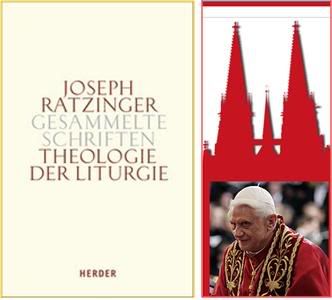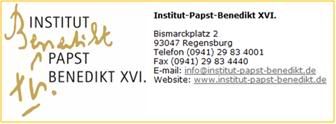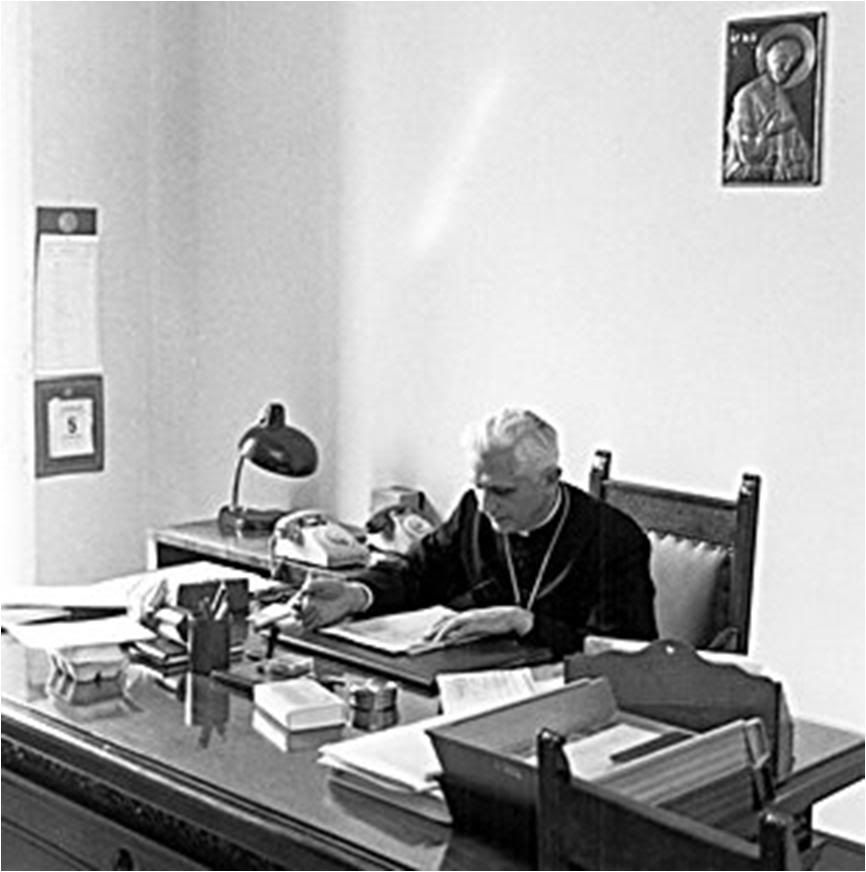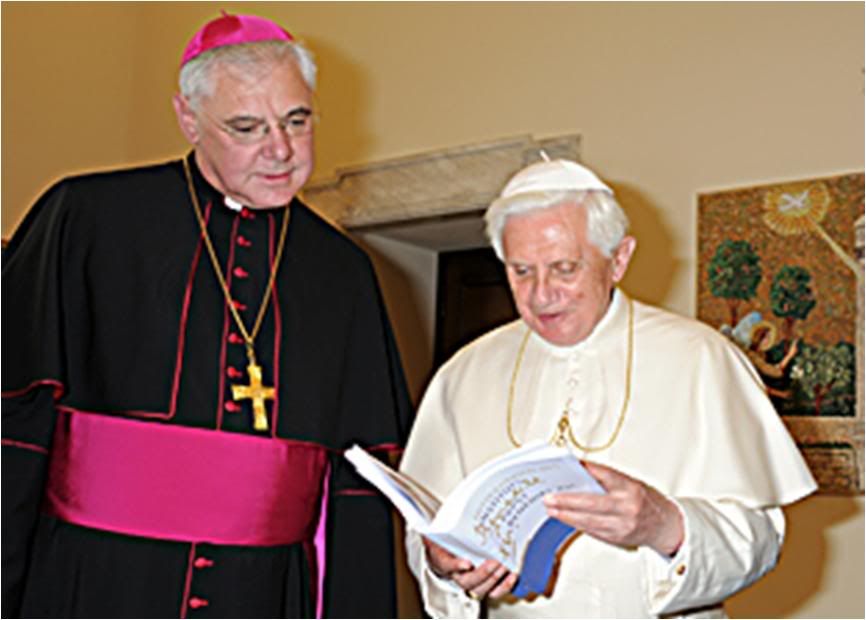 Here is a translation of Bishop Gerhard Mueller's presentation at the Vatican news conference
Here is a translation of Bishop Gerhard Mueller's presentation at the Vatican news conference
Tuesday noon on the Collected Works of Joseph Ratzinger [Joseph Ratzinger: GESAMMELTE SCHRIFTEN].
His presentation was delivered in German.
 The first volume out is Volume XI,
The first volume out is Volume XI,
THE THEOLOGY OF LITURGY.
 The publisher is the newly-established Pope Benedict XVI
The publisher is the newly-established Pope Benedict XVI
Institute, which will be formally inaugurated on Oct. 30.
The collected works
of Joseph Ratzinger
by Mons. Gerhard Mueller
Bishop of Regensburg
Translated from
 Also published in
Also published in
the 10/22/08 issue of

I
Pope Benedict XVI is one of the great theologians to occupy Peter's Chair. In the long list of his predecessors, one can cite that eminent 18th century erudite, Benedict XIV (1740-1758), then back to Pope Leo the Great (440-461) who formulated the decisive recognition of the Christologic confession in the Council of Chalcedony (451).

In the course of his long academic activity as professor of Fundamental Theology and Dogma, Pope Benedict XVI elaborated a theological work that that places him without doubt among the most important scholars of the 20th century and the early 21st century.
For more than 50 years, the name of Joseph Ratzinger has been linked to an original comprehensive vision of systematic theology.
His writings unite scientific knowledge of theology to a living Gestalt of a lived faith. As a science that has its genuine place within the Church, theology can show the special calling of man as creature and image of God.
In his scientific activity, Benedict XVI has always been able to draw on his wondrous knowledge of history of theology and of dogmas, which he can transmit in an illuminating way to highlight the divine vision of man.
That vision becomes accessible to many through the lexical and linguistic vocabulary that Joseph Ratzinger has adopted over decades. Complex themes are not subjected to complicated reflections that are beyond common understanding, but made transparent in their intimate linearity.
At the center of everything is the divine will to speak to every man, and his Word that becomes the light to illuminate every man today (Jn q,9).
In his academic career, theology professor Joseph Ratzinger taught at the universities of Freising, Bonn, Munster and Tuebingen, ending up finally in Regensburg, where he worked from 1969 until he was named Archbishop of Munich and Freising in 1977.
Cardinal Ratzinger remained close to the city and the diocese of Regensburg even during the long period when he was Prefect of the Congregation for the Doctrine of the Faith (1882-2005). He came regularly to visit his brother Georg, who was for many years the director of the famous Boys Choir of Regensburg Cathedral (1964-1994). Unforgettable are the homilies he delivered at the Cathedral on a variety of liturgical celebrations.
His parents Josef and Maria Ratzinger, along with his sister Maria, are buried in the cemetery of Regensburg-Ziegetsdorf. And of Pentling, his residence just outside the gates of the episcopal city of Regensburg, he once said that after so many years of moving from place to place and living in different houses, "we (the Ratzinger siblings) were once more at home".
During his pastoral visit in 2006 to his native Bavaria, his
Regensburg Lecture, the lectio magistralis that was a magic and historic moment in university history - and not only for Regensburg - underscored once again the intimate connection between faith and reason.
Neither reason nor faith can be considered independently of each other, nor can they, independently, arrive at their respective goals. Correcting and purifying each other, reason and faith are able to guard against dangerous pathologies. In this sense, Pope Benedict XVI adheres to the great tradition of the theological sciences, which in the global structure of the University can function as an all-comprehensive connective element.
Thus Regensburg became in a way the
genius loci in which to put together and take custody of the theological
opera omnia of Joseph Ratzinger. The episcopal see of Regensburg, with its eminent figures of erudite bishops like St. Albertus Magnus (1260-1262) and Johann Michael Sailer (1821-1832), has always advocated the unity of the episcopal and academic Magisterium in order to confirm the rationality of the faith and the pastoral fecundity of science.
This was a tradition carried forward by Archbishop Michael Buchburger (1927-1961) under whose direction, the
Lexikon für Theologie und Kirche took shape - a basic text that became globally known and has now reached three editions.
Thus, this episcopal city is the appropriate home of the Pope Benedict XVI Institute.
In my capacity as Bishop of Regensburg (since 2002), I have been personally entrusted by the Holy Father with the publication of his Collected Writings in 16 volumes.
As a student at university, I dedicated myself to an in-depth reading of the theological treatises of Joseph Ratzinger. I was particularly struck and lastingly impressed by his work of genius
Introduction to Christianity, which in that tempestuous time of student revolts and a general theological disorientation, offered a sure key for approaching the profound mystery of Christian revelation.
The specialized reader may easily observe this in my book
Catholic dogma for study and for praxis which was first published by Herder in 1995 and has had various editions since then.
The elaboration of this editorial project was carried out in close consultation with Pope Benedict XVI. Every single volume was personally authorized by the Holy Father, both in the choice of the thematic approach and the choice of the texts themselves. Minor single articles are indicated by references to where they may be found.
It is therefore legitimate to refer to this as the vital testimony of the theology of Joseph Ratzinger/Benedict XVI, in which the center of interest was not just putting together and cataloguing the texts, but
the systematic study in depth of theological themes through a freshly-conceived arrangement which brings out their connections and allows a comprehensive overview.
By the express desire of the Holy Father, the
Collected Writings are being published under the name of Joseph Ratzinger.
In order to realize this project, I established the Pope Benedict XVI Institute in Regensburg. It is the seat that will host an exhaustive documentation of the life, thought and work of the theologian, bishop and Pope Joseph Ratzinger/Benedict XVI.
With the preparation of all material, published as well as previously unpublished, highlighting the biographical and theological context of each, and the beginnings of a specialized library, we have created the ideal conditions for a wide-ranging analysis of the
Opera omnia.
I wish to express my sincere thanks to the Holy Father. The great demonstration of confidence expressed by him in entrusting to me the responsibility for overseeing the publication of his works, constitutes a joy for me, as well as a great commitment.
II
The present edition of the
Collected Writings is meant to be the 'definitive edition' in German of the work of the theologian Joseph Ratzinger.
The objective is to have the most complete presentation possible of works that have been published before, supplemented with texts that have been unpublished before, or that have not yet appeared in German, presented in a systematic arrangement that links chronological and thematic aspects.
Pre-existing monographs are included without changes in the
Collected Writings, and are supplemented from time to time by later texts that are related. According to a practice previously adopted by Joseph Ratzinger, texts of a specifically scientific or academic nature are accompanied by texts of other literary genres, like contributions to encyclopedias and book reviews, as well as homilies and meditations.
Earlier volumes of essays published at certain stages of his work as theologian, bishop and Prefect of the CDF, that put together contributions that were thematically linked, have been taken apart, and the individual texts re-ordered into the new editorial arrangement.
The
Collected Writings opens - I am referring here to the numbering of the volumes, which does not necessarily correspond to their publication date) - with the two works submitted by Joseph Ratzinger for academic validation: his graduation thesis on Augustine's doctrine of the Church, and his dissertation for his Habilitation for university professorship, on the doctrine of Revelation in Bonaventure. These are supplemented with other essays and texts about Augustine and Bonaventure.
Volume II takes off from the inaugural lecture of Professor Ratzinger,
The God of the faith and the God of philosophers, at the University of Bonn in 1959, to which have been added all his subsequent texts on the theme of faith and reason. It includes all his reflections on the historical and ideal foundations of Europe.
Volume IV starts with the
Introduction to Christianity (1969) with other texts on the profession of faith, Baptism, conversion, following Christ and fulfillment of Christian existence.
Volumes V-XII are oriented in the broadest sense to the thematic canon of systematic theology.
Volume V has all the texts that refer to the doctrines of creation and the anthropology and doctrine of grace, presenting Mariology as the salvific concretization of the doctrine of grace.
Volume VI takes off from JESUS OF ANZARETH, and includes all the writings on Christology.
Volumes VII and VIII are dedicated to another focal point of Joseph Ratzinger's research - Ecclesiology. Specifically, Volume VII is a global collection of texts - those written in preparation for the Second Vatican Council, the accounts of the Council itself and the commentaries published after each session, as well as interventions related to the reception of the Conciliar texts.
Volume VIII contains the ecclesiological writings in the strict sense, and includes all the writings on ecumenism.
Volume IX concerns the intersection between Fundamental Theology and Dogmatics, and includes all the writings on theological gnoseology and hermeneutics, including his studies about Scriptures and the specific contexts of Revelation, Tradition, Scriptures and Magisterium.
Volume X opens with
Eschatology from 1977, the only dogmatic-theological manual of Joseph Ratzinger that has been published to date, supplemented with his later texts on the themes of hope, death, resurrection and eternal life.
In Volumes XI and XII, the author focuses expressly on other aspects of central interest to his thinking. With Volume XI,
The Theology of Liturgy, with which the Holy Father wished to inaugurate the publication of the
Complete Writings, he places his
Opera omnia under the standard of a coherent theocentrism.
Volume XII puts together texts that are relevant to ecclesiology and the doctrine of Sacraments and spiritual service, under the title of 'Announcers of words and servants of joy'.
Volume XIII brings together Joseph Ratzinger's numerous interviews, from the brief early ones, to the three that were published as books (with Vittorio Messori in 1984, and with Peter Seewald in 1996 and 2000).
Volume XIV is the most exhaustive possible collection of Joseph Ratzinger's vast homiletic production, including many sermons and meditations that have never been published before.
Volume XV brings together the autobiography that came out in 1997-1998, with other texts of biographical character and interventions of the personal type, for example, his numerous declarations on John Paul II, or on his brother Georg, as well as various discourses on jubilees, appreciations, etc.
Volume XVI offers a complete bibliography of the works of Joseph Ratzinger in German, and an exhaustive systematic index of all the volumes, which allows an overview of the interior coherence and consistency of the complete works in their entirety. The individual volumes each have detailed indices with a list of the scriptural names and references.
A few more details from the news conference, outside of the above presentation can be found in this report:
Joseph Ratzinger's Opera Omnia
Pier Giuseppe Accornero
Translated from

VATICAN CITY - At the rate of two volumes a year, the publication of the
Collected Writings of Joseph Ratzinger as theologian -"which has, in its center, the divine will to peak to every man so that his Word may become the light that illumines every man" - will be completed in 2016.
Considering that the first book in the series has 757 pages, that each book is to come out in two volumes, and that there are 16 volumes in all, one arrives at an estimated 13,000-15,000 pages that includes footnotes, references and indices.
It is certainly a theological, cultural and editorial event of great importance.
It is significant that the first volume of the series has come out during the current Bishops' synod assembly on the Word of God - which drew great attention and study from the Bavarian theologian from his early career.
The publication is necessarily in German since Joseph Ratzinger's extensive literary production before he became Pope was predominantly written in German originally.
It is a prodigious body of work which puts together at least 700 published books and articles, plus many texts that have not previously been published.
Herder Verlag is the publisher. Translations of the first volume which was released this month will be coming soon in Italian (May 2009), English, French, Spanish and Portuguese, under the supervision of Libreria Editrice Vaticana (ELV), the Vatican publishing house which has all the rights to Joseph Ratzinger/Beneduict XVI's written aND spoken words, as well as exclusive rights to his Pontifical writings.
[
The rest of the article is about Mons. Mueller's presentation.]
 From the webpage of the Institut Benedikt XVI,
www.bistum-regensburg.de/borPage003770.asp
here are the titles of the 16 volumes in the
From the webpage of the Institut Benedikt XVI,
www.bistum-regensburg.de/borPage003770.asp
here are the titles of the 16 volumes in the COLLECTED WRITINGS:
1.
Volk und Haus Gottes in Augustins Lehre von der Kirche
Die Dissertation und weitere Studien zu Augustinus von Hippo
(The People and the House of God in Augustine's Teachings on the Church:
Dissertation and further studies on Augustine of Hippo)
2.
Das Offenbarungsverständnis und die Geschichtstheologie Bonaventuras
Die ungekürzte Habilitationsschrift und weitere Bonaventura-Studien
(Revelation and St. Bonvaenture's Theology of History:
The unabridged* Habilitation dissertation and other studies on Bonaventure)
[Does this mean it includes the first part of the dissertation that he was forced to cut out
when he had to re-submit it for approval by his academic advisers?]
3.
Der Gott des Glaubens und der Gott der Philosophen
Die wechselseitige Verwiesenheit von fides und ratio
(The God of Faith and the God of Philosophers: The reciprocal relationship between faith and reason)
4.
Einführung in das Christentum
Bekenntnis – Taufe – Nachfolge
(Introduction to Christianity: Profession of Faith - Baptism - Discipleship)
5.
Herkunft und Bestimmung
Schöpfung – Anthropologie – Mariologie
(Origin and Destiny: Creation - Anthropology- Mariology)
6.
Jesus von Nazareth
Spirituelle Christologie
(Jesus of Nazareth: Spiritual Christology)
7.
Zur Theologie des Konzils
Texte zum II. Vatikanum
(On the Thology of the Councl: Texts on Vatican II)
8.
Zeichen unter den Völkern
Schriften zur Ekklesiologie und Ökumene
(Signs among Peoples: Writings on Ecclesiology and Ecumenism)
9.
Offenbarung – Schrift – Tradition
Hermeneutik und Theologische Prinzipienlehre
(Revelation - Scripture - Tradition: Lessons on hermeneutic and theological principles)
10.
Auferstehung und Ewiges Leben
Beiträge zur Eschatologie
(The Resurrection and Eternal Life: Essays on eschatology)
11.
Theologie der Liturgie
Die sakramentale Begründung christlicher Existenz
(The Theology of Liturgy: The sacramental foundation of Christian existence) - Published October 2008
12.
Künder des Wortes und Diener eurer Freude
Zur Theologie und Spiritualität des Ordo
(Announcers of the Word and Servants of your Joy: The theology and spirituality of the Ordo)
12.
Im Gespräch mit der Zeit
Interviews – Stellungnahmen – Einsprüche
(In Conversation with the Times: Interviews - Positions - Objections)
14.
Predigten zum Kirchenjahr
Meditationen, Gebete, Betrachtungen
(Homilies for the Liturgical Year - Meditations, Prayers, Observations)
15.
Aus meinem Leben
Autobiographische Texte
(My Life: Autobiographical Texts)
16.
Bibliographie und Gesamt-Register
(Bibliography and Complete Index)
10/23/08
P.S. Tomorrow's issue (10/24/08) of
L'Osservatore Romano carries this picture of Bishop Mueller presenting Volume XI of the Complete Works to the Holy Father, who received him in private audience Wedensday afternoon - after the presentation news conference.

 I must say it is beyond exciting and thrilling that the undertaking on the Collected Writings of Jossph Ratzinger has been done so promptly. Very few authors get to see their collected works published in their lifetime - nor have such an impressive body of work, to begin with. One inestimable advantage is that the author himself has his say on how the writings are presented - full editorial control in a way, which authors posthumously anthologized do not have.
I must say it is beyond exciting and thrilling that the undertaking on the Collected Writings of Jossph Ratzinger has been done so promptly. Very few authors get to see their collected works published in their lifetime - nor have such an impressive body of work, to begin with. One inestimable advantage is that the author himself has his say on how the writings are presented - full editorial control in a way, which authors posthumously anthologized do not have.
The other wondrous thing is that there will be Part 2 of the Joseph Ratzinger literary saga - in the form of his Magisterium. The Vatican publishing house has certainly been very 'with it' in this respect - and I have been meaning to do a round-up of all the publications they have released so far on Benedict XVI in the past 42 months. The full record of the Magisterium is found in the series on the INSEGNAMENTI (Teachings), which has now been published up to Vol III, Part 2, which contains all the Papal texts in the latter part of 2007.
I believe from what I have been reading about the JR Collected Writings (JR-CW) that Part 2 of the JON book will be included in Volume VI of the JR-CW on Christology.